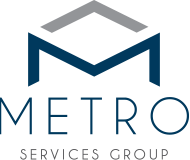08 May COVID-19: How To Prepare A Building For Re-Entry
By Dennis Kaiser
This is the second in a three-part series by Metro Services Group’s facility experts who explain how they help deliver cleaner work environments in the coronavirus era. Today, the professionals break down how to prepare a building for re-entry. Yesterday, janitors and engineers on the front-lines at properties shared how their building safety and training measures help fight COVID-19. In the final installment, Metro’s team will offer advice for when buildings welcome tenants back from their COVID-19 lockdowns.
Commercial real estate landlords are shifting their eye toward a day when workers return to office buildings once stay-at-home orders are lifted from the COVID-19 pandemic. Landlords are now focused on creating a safe environment, as they prepare to welcome tenants and visitors back and are tapping into facility experts to help them do just that.
Since the virus swept across the United States, properties continued to operate, some on a limited basis to accommodate companies that remained open. While others throttled down to bare minimum operations and staffs. During this period facility crews, including building engineers, had to learn new guidelines, practices and protocols.
“Essential workers had to practice social distancing, said Marlene Machemy, Metro’s engineering manager who works with building teams on mechanical and operating systems. “It was a learning curve, and we had to allow flexibility in schedules, so just one engineer was on site at a time. When there are more engineers needed, they had to be able to spread out in different areas, so as not to run into each other. The goal is safety and to reduce contact, if possible.”
Step-By-Step
That involved discussions with engineers to figure out the new steps that this COVID-19 period of time brought about that the engineering and maintenance teams had not even thought about before.
Because new information, guidelines or orders are published on a daily basis, they constantly have to reassess the situation and adjust their plan accordingly. The new era required facility teams to consider many variables and work environments, said Machemy. It requires daily communication to figure out what works for each team of engineers and each building. “We knew we couldn’t just follow a rigid plan” said Machemy. The goal is to “ensure the safety of engineers and reduce the risk of contamination.” On top of rotating schedules and physical distancing, new cleaning routines had to be implemented, including making sure that any shared equipment such as tools, computers and kitchen appliances are properly disinfected between transitions.
As the COVID-19 situation has evolved, Machemy notes most of her day is spent on the phone, working to understand needs and adjust plans with engineers.
Restoring Proper Functioning Order
If not already done, adjusting the HVAC system to allow for higher ventilation rate and maximizing outside air coming in the building is necessary before re-occupancy, says Machemy. The next challenge, she points out, will be to adjust the system as more tenants will bring a new dynamic to the building. Maximizing outside air while maintaining tenants’ comfort and keeping the building within a set range of humidity and temperature levels is a tricky balance, especially if not in a temperate climate. This will require the engineers to tweak the system multiple times a day. Communicating early with tenants and asking for their patience may help avoiding unnecessary temperature complaints.
Machemy also notes that engineers may want to implement air flushing sequence with maximum outside airflows before occupancy, as suggested by ASHRAE. The process may be repeated after tenants depart to ensure the healthiest air environment possible.
Another ASHRAE requirement, Machemy said, is to upgrade HVAC air filters to MERV-13 (MERV-14 is preferred) before re-occupancy. If MERV-13 is not compatible, the highest filter compatible should be installed. Longer term, she suggests engineers create a pandemic mode on the building automation system that can be turned on, override or shutdown as needed.
Another area Machemy said must be examined before reopening is water quality if a building has been idle for a period of time. Standing water may cause conditions ideal for growth of legionella and other biofilm-associated bacteria. It can also result in improper level of disinfectant such as chlorine. Flushing the building water system through all points of use every couple of days is a good way to avoid such issues, and should be done even after re-opening in low-occupancy buildings.
Welcome Back Tenants
When buildings reopen, the mechanical systems and other building components will require tune-ups to be ready. But perhaps one of the biggest areas of adjustment will be making sure people maintain the physical distancing required. “When tenants come back, that’s a big concern with property managers,” said Machemy. Among the additions being explored are sneeze guards at security desks, blocking doors open so they don’t have to be touched when workers enter, or other simple steps that can be done.
Among the more extensive changes may be a reconfiguration of office space to accommodate open spaces to be more confined, or have private spaces for workers.
Lastly, it is important to keep in mind the CDC guidelines regarding spaces where infections were known to have occurred or where someone who contracted the virus had been. The CDC now says if someone who has COVID-19 was in the workspace, facility crews should wait a minimum of 24 hours before entering the space to clean and disinfect the area. It is also recommended by the CDC, that once the area has been appropriately disinfected, it can be opened for use.
As landlords shift attention to a time when workers return to their buildings, they will continue to focus on creating safe environments. Facility experts will be counted on to help accomplish those goals.




Sorry, the comment form is closed at this time.